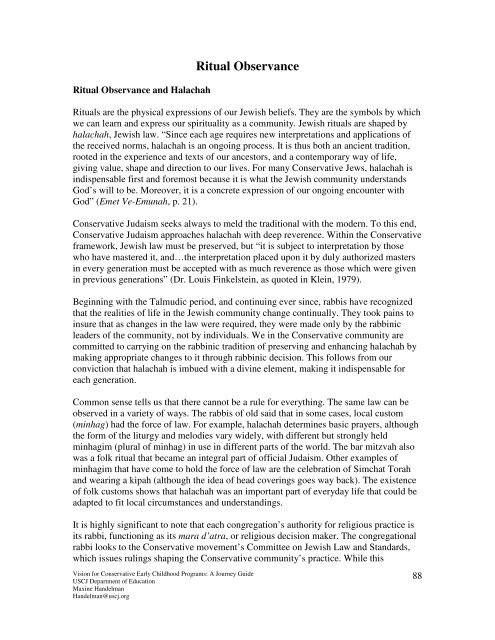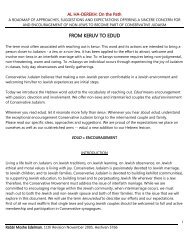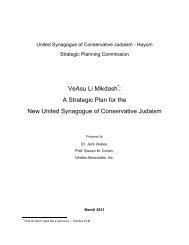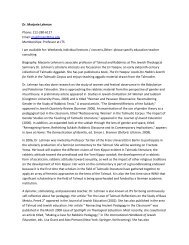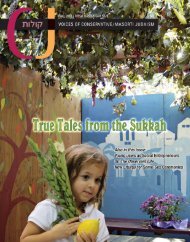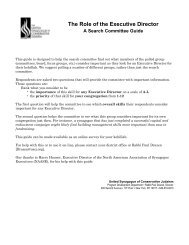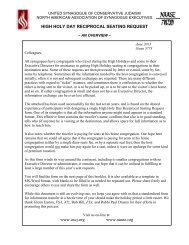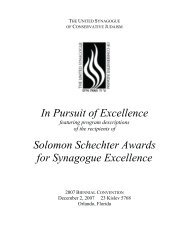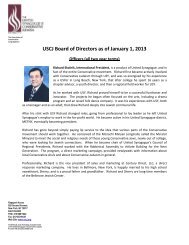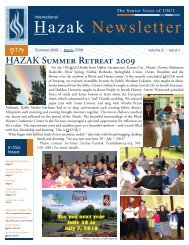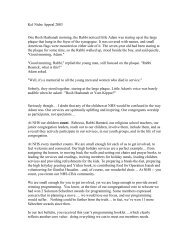Vision for Conservative Early Childhood Programs: A Journey Guide
Vision for Conservative Early Childhood Programs: A Journey Guide
Vision for Conservative Early Childhood Programs: A Journey Guide
Create successful ePaper yourself
Turn your PDF publications into a flip-book with our unique Google optimized e-Paper software.
Ritual Observance and Halachah<br />
Ritual Observance<br />
Rituals are the physical expressions of our Jewish beliefs. They are the symbols by which<br />
we can learn and express our spirituality as a community. Jewish rituals are shaped by<br />
halachah, Jewish law. “Since each age requires new interpretations and applications of<br />
the received norms, halachah is an ongoing process. It is thus both an ancient tradition,<br />
rooted in the experience and texts of our ancestors, and a contemporary way of life,<br />
giving value, shape and direction to our lives. For many <strong>Conservative</strong> Jews, halachah is<br />
indispensable first and <strong>for</strong>emost because it is what the Jewish community understands<br />
God’s will to be. Moreover, it is a concrete expression of our ongoing encounter with<br />
God” (Emet Ve-Emunah, p. 21).<br />
<strong>Conservative</strong> Judaism seeks always to meld the traditional with the modern. To this end,<br />
<strong>Conservative</strong> Judaism approaches halachah with deep reverence. Within the <strong>Conservative</strong><br />
framework, Jewish law must be preserved, but “it is subject to interpretation by those<br />
who have mastered it, and…the interpretation placed upon it by duly authorized masters<br />
in every generation must be accepted with as much reverence as those which were given<br />
in previous generations” (Dr. Louis Finkelstein, as quoted in Klein, 1979).<br />
Beginning with the Talmudic period, and continuing ever since, rabbis have recognized<br />
that the realities of life in the Jewish community change continually. They took pains to<br />
insure that as changes in the law were required, they were made only by the rabbinic<br />
leaders of the community, not by individuals. We in the <strong>Conservative</strong> community are<br />
committed to carrying on the rabbinic tradition of preserving and enhancing halachah by<br />
making appropriate changes to it through rabbinic decision. This follows from our<br />
conviction that halachah is imbued with a divine element, making it indispensable <strong>for</strong><br />
each generation.<br />
Common sense tells us that there cannot be a rule <strong>for</strong> everything. The same law can be<br />
observed in a variety of ways. The rabbis of old said that in some cases, local custom<br />
(minhag) had the <strong>for</strong>ce of law. For example, halachah determines basic prayers, although<br />
the <strong>for</strong>m of the liturgy and melodies vary widely, with different but strongly held<br />
minhagim (plural of minhag) in use in different parts of the world. The bar mitzvah also<br />
was a folk ritual that became an integral part of official Judaism. Other examples of<br />
minhagim that have come to hold the <strong>for</strong>ce of law are the celebration of Simchat Torah<br />
and wearing a kipah (although the idea of head coverings goes way back). The existence<br />
of folk customs shows that halachah was an important part of everyday life that could be<br />
adapted to fit local circumstances and understandings.<br />
It is highly significant to note that each congregation’s authority <strong>for</strong> religious practice is<br />
its rabbi, functioning as its mara d’atra, or religious decision maker. The congregational<br />
rabbi looks to the <strong>Conservative</strong> movement’s Committee on Jewish Law and Standards,<br />
which issues rulings shaping the <strong>Conservative</strong> community’s practice. While this<br />
<strong>Vision</strong> <strong>for</strong> <strong>Conservative</strong> <strong>Early</strong> <strong>Childhood</strong> <strong>Programs</strong>: A <strong>Journey</strong> <strong>Guide</strong><br />
USCJ Department of Education<br />
Maxine Handelman<br />
Handelman@uscj.org<br />
88


